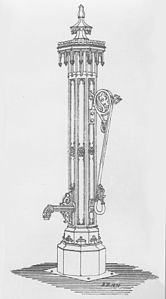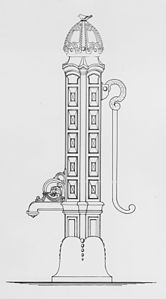Hand lever pumps in Leipzig
In the cityscape of Leipzig you can find 30 restored, artistically designed hand lever pumps of various types and well over 30 unrestored and in some cases badly dilapidated pumps. There are an even larger number of places that reveal through a special stone base plate that a pump once stood there and the well is still below. 147 of these objects are under monument protection .
history
Up until the beginning of the 16th century, the water was supplied exclusively via scoop and draw wells . The central water supply began with a wooden pipeline from the Marienquelle and the establishment of the water arts at Pleißemühlgraben . But even with the establishment of the drinking water network from the second half of the 19th century, the wells initially retained their importance. There were numerous public fountains, especially in the areas of the expanding city. In addition to supplying households, they served as drinking troughs for teams of horses and small animals as well as for fighting fires. (See also section "Fountains as part of Leipzig's water supply" in the article Fountains in Leipzig .)
From the last third of the 19th century, the wooden pumps on the wells were replaced by cast iron ones. Wealthy Leipzig could afford to use artistic pump housings that were in keeping with contemporary tastes, even in the outskirts. (For the types see below.)
From 1879 to 1941, the Leipzig waterworks kept a handwritten notebook on the condition of all public fountains in Leipzig, titled Brunnen Nationale . The numbering in it goes up to 282. This number is therefore also used to add the total number of manual lever pumps that were previously in Leipzig. In addition, there are about ten in city cemeteries. Numerous new bores were carried out until around 1910. The last well in public space was drilled in 1934.
With the further expansion of the drinking water network and the acceptance of horse-drawn vehicles in the city area, hand-operated pumps lost their importance from the 1920s. Some of them were used again during World War II when the drinking water supply failed in parts of the city after air raids. After the Second World War, the majority of the pumps fell into disrepair, or the wells were built over by traffic and other projects.
restoration
In the 1980s, attention was drawn to the cultural and historical significance of hand lever pumps, and the first approaches to the restoration of pumps were developed. The first restorations took place in the early 1990s, and the pumps or wells that still existed were added to the city's list of cultural monuments . The restorations are carried out by Bau und Service Leipzig GmbH , a subsidiary of the Leipzig municipal waterworks . The client is the city of Leipzig, which owns the manual lever pumps. Numerous sponsors contribute to the financing of the restoration . The restoration is carried out using original parts as well as by making new individual parts. After the restoration, the pumps are functional and will be serviced by Bau und Service Leipzig GmbH. The water supplied is not drinking water. The number of the well from the Well Nationale is again attached to each restored pump .
Pump types
- Historical drawings of the pump types
Of the original eleven different cast-iron housing types of the Leipzig manual lever pumps, eight could still be found in the 1990s. These were the main types dolphin, gothic, small lion, bird cage and large lion and, in some examples, the high pump (Dimpfelstraße in Schönefeld, Rossmarkt in Liebertwolkwitz), the small fluted pump (Thüringer Straße in Plagwitz) and the pump with capital ( Bruhnsstrasse in Sellerhausen-Stünz). The design of the Löwenbrunnen on the Naschmarkt is also a manual pump.
The housings of the main types in Leipzig have a remarkable artistic design, as they mostly emerged from artistic competitions.
The pumps are mounted on a granite slab that covers the well below. On some pumps, this plate contains wells that served as watering points for birds and small animals. With the advent of the central sewer system, the drainage of the pumps was connected to it in order to avoid puddles.
Type dolphin
The dolphin pump type is the oldest of the "jewelry types". A drawing for this type is dated 1875. The artist who designed it is not known. The eponymous dolphin is on the tip of the slim, ornate cast iron shaft and is supposed to symbolize the connection to the water. The handle is made of wrought iron. The cast parts were delivered by the Jacobiwerk Meißen . The dolphin type was the most common of the pump types.
Since no original dolphin was available at the beginning of the restoration work, a corresponding model from the original drawing and dolphin representations was recreated on other fountains. On the originals, the dolphin was made of sheet metal, on the restored pumps it is a bronze cast.
The locations of the restored pumps: Katharinenstrasse 11 ( map ), Lortzingstrasse, behind the local history museum ( map ), Marienplatz ( map ), Hohmannstrasse / Berliner Strasse ( map ), Crusiusstrasse / Dresdner Strasse ( map ), Ossietzkystrasse / Robert-Blum-Strasse ( Map ), Mariannenstrasse / Rosa-Luxemburg-Strasse ( map ), Windorfer Strasse (Taborkirche) ( map )
Gothic type
This type is also called " neo-Gothic ". The oldest dating of a drawing of this type relates to the year 1877. The author of the artistic design of the pump is not known.
The pump has an octagonal cross section. The numerous cast-iron decorative parts with Gothic motifs are screwed onto the pump body. The hood of the pumps with the crenellated crown was formerly made of zinc sheet. For the reconstruction, some decorative parts had to be “copied”.
The locations of the restored pumps: Burgstrasse ( Thüringer Hof ) ( map ), Schützenstrasse ( map ), Waldstrasse 48 ( map ), Neumarkt / Grimmaische Strasse ( map ), Brühl (Romanushaus) ( map ), Pfaffendorfer Strasse / Ernst-Pinkert-Strasse ( Map )
Type little lion
The little lion type refers to the Leipzig heraldic animal. The design emerged as the winner in a competition in which the municipal art association and the Dürerbund participated in 1908. The name of the artist is no longer known.
An octagonal foot carries a round pump shaft, which tapers upwards and has a grooved upper part, on which there is a structure with four turrets. A lion sitting on it is supported by a shield with the city coat of arms. The structure of the original pumps was made of sheet metal, the restored ones are cast. The outlet is designed as a lion head.
The locations of the restored pumps: Universitätsstrasse (Städtisches Kaufhaus) ( map ), Bernhard-Göring-Strasse / Fichtestrasse ( map ), Ludwig-Erhard-Strasse 53 ( map ), Davidstrasse / Sebastian-Bach-Strasse ( map ), Gräfestrasse 10 ( Map ), Huygensstraße / Georg-Schumann-Straße (implementation from Blücherplatz) ( map )
Type bird cage
A small bird sits on an upper end of the pump that is reminiscent of a cage. This was previously interpreted as a sparrow and the type of fountain is therefore also known as a sparrow fountain. The design comes from Bruno Wollstädter , who received first prize for it in a competition initiated by the city council in 1910.
A round shaft rises from a bell-shaped base, which is decorated with four by five three-dimensional squares from the height of the spout. There is an elaborate decoration on the spout, while the handle is kept simple except for an S-shaped curve at the joint.
The locations of the restored pumps: Peterssteinweg / Münzgasse ( map ), Magazingasse / Neumarkt ( map ), Lobstädter Straße 9 ( map ), Hedwigstraße / Eisenbahnstraße ( map ), Gorkistraße / Volksgartenstraße ( map )
Big lion type
The type of pump for the Great Lion also comes from a competition from 1910. The creators are the architect Heinrich Quint and the sculptor Arthur Kuntzsch.
A relatively massive pump body with a square cross-section rises above a protruding base. The side parts only have a simple decoration, which has elements of Art Nouveau at the end below the seated base . The lion sitting on the base was originally made of zinc sheet and is made in restorations as a galvanoplasty that is poured with plaster of paris.
The locations of the restored pumps: Neumarkt 24 ( map ), Bornaische Straße 3c ( map )
literature
- Hans Hoffmann: Hand lever pumps in Leipzig , in: Leipziger Blätter No. 7, 1985, p. 22
- Horst Riedel: Stadtlexikon Leipzig from A to Z . PRO LEIPZIG, Leipzig 2005, ISBN 3-936508-03-8 , p. 481
- Jens Müller: Leipziger Handschwengelbrunnen - Objective of monument preservation , City Council of Leipzig 1987
- Katharina Linzner: Hand lever pumps of the City of Leipzig , accompanying text for the exhibition in the Leipzig City Archives March to September 1999
Web links
- Ursula Drechsel: Hand lever pumps in Leipzig near Leipzig -lesen
- Construction and Service Leipzig GmbH
- Leipzig closer
Individual evidence
- ↑ See list of manual lever pumps in Leipzig
- ↑ "Brunnen Nationale" - a handwritten notebook from Wasserwerke Leipzig about public fountains in Leipzig and their control, with object numbering from 1 to 282, available from Bau und Service Leipzig GmbH
- ↑ a b Jens Müller: Leipziger Handschwengelbrunnen - Monument conservation objectives , City Council of Leipzig 1987














